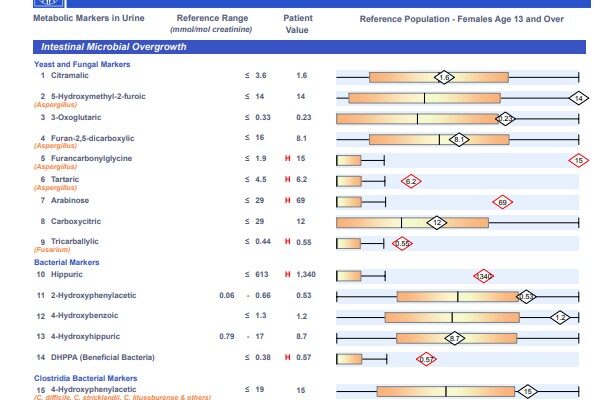
10 Great Reasons To Use The Organic Acids Test
By Kurt N. Woeller, DO
The Organic Acids Test is a central laboratory profile to perform for anyone dealing with a chronic health issue. Here are the top 10 reasons to do the OAT from Mosaic Laboratory (formally Great Plains Laboratory):
1. The OAT tests for various fungal toxins, including specific markers for candida, as well as other fungus such as mold and yeast residing in the gut. Many individuals rely on stool testing for a candidiasis diagnosis. However, a stool test is often negative for candida overgrowth, while the OAT often detects the presence of candida and yeast toxins. The OAT is overall more sensitive for candida analysis.
2. The OAT evaluates the presence of specific toxins related to various clostridia bacteria. Clostridia bacteria such as Clostridia difficile (C. diff.) can lead to digestive problems and poor health. For example, certain strains of C. diff. can produce toxins which cause inflammation, bleeding, and diarrhea within the digestive system. However, there are other clostridia toxins that work outside the digestive system. The main toxins evaluated on the OAT linked to different strains of clostridia are HPHPA and 4-cresol. Both HPHPA and 4-cresol can inhibit a dopamine converting enzyme leading to excess dopamine in the brain and nervous system.
3. The information from the OAT helps to prioritize decisions about treatment interventions between candida (fungus) and clostridia (bacteria). Treating for candida alone when the clostridia bacterial toxins of HPHPA and 4-cresol are present may lead to significant problems aggravating the digestive system, but also leading to adverse changes in neurochemicals affecting behaviors, cognitive abilities, mood, and mental stability.
4. The test analyzes oxalate (aka oxalic acid). Oxalate is a compound found in many foods such as nuts (e.g., almonds), fruit (e.g., berries) and certain vegetables (e.g., spinach). Oxalate can also be produced by candida overgrowth, aspergillus mold, as well as certain metabolic imbalances linked to deficiency in oxalate metabolizing enzymes. High oxalate is often associated with joint and muscle pain but can lead to bladder and bowel discomfort as well. Severe cases of oxalate accumulation can cause kidney stones. Oxalate can also trap heavy metals such as mercury, lead, and arsenic in the body and lead to mineral imbalances.
5. The OAT evaluates mitochondrial imbalances. The mitochondria are the energy factories of our cells and produce large amounts of adenosine triphosphate (ATP). ATP acts as energy currency for our body. Mitochondria are often stressed because of toxins from candida, bacteria, oxalate, heavy metals, and environmental chemicals. Mitochondrial dysfunction is common in many chronic health disorders.
6. The OAT evaluates for imbalances in dopamine and norepinephrine. The relationship between these two important brain chemicals is critical for attention, focusing, mood, calmness, and other functions of the nervous system.
7. The OAT evaluates for deficient or excess of serotonin, an important brain chemical for mood, fine and gross motor skills, calmness, and sleep. There are other markers evaluated on the OAT that can indicate toxic stress in the brain and nervous system. One of these potentially toxic compounds is called quinolinic acid (QA). Elevated QA can be toxic in the brain triggering increased receptor activity that allows for increased influx of calcium into a brain cell. This mechanism can lead to a host of cell problems causing or contributing to brain cell death and destruction.
8. The OAT reveals two specific chemicals related to folate metabolism. Folate is linked to the methylation cycle that supports the inner workings of the cells related to DNA function and metabolism. Poor folate metabolism can lead to cognitive problems.
9. The OAT measures nutritional markers such as vitamin B6, vitamin B5, vitamin C, CoQ10, as well as N-Acetylcysteine (NAC). NAC is necessary as a precursor for the antioxidant glutathione.
10. The OAT tests for glutathione deficiency. Glutathione is a powerful antioxidant and protects against toxicity. The lack of glutathione leads to oxidative stress within the brain and nervous system which causes poor attention, focusing, and overall cognitive challenges. Glutathione deficiency can also compromise immune system health. Glutathione is a necessary compound that is involved with liver detoxification of chemicals.
In summary, the Organic Acids Test from Mosaic Diagnostic Laboratory is an essential profile for anyone seeking additional information related to underlying gut derived bacterial and fungal toxins, as well as evaluating for less known metabolic imbalances such as mitochondrial function. It is not a test limited to just a few conditions, but instead can be done on anyone dealing with a complicated and chronic health problem.




